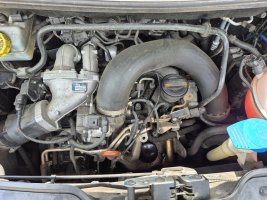- Home
- Forums
- VW California T5 T6 & T6.1 Specific Sections
- VW California T5,T6 & T6.1 Specific Sections
- EGR Valve
You are using an out of date browser. It may not display this or other websites correctly.
You should upgrade or use an alternative browser.
You should upgrade or use an alternative browser.
CaliGem
VIP Member
Oh, I thought you just spray it into the air tube and it makes the van run rough on idle for a second each spray?You have to remove the egr valve and clean the internal areas loosening the tar black residue with the spray you have bought, it is a very dirty job and you will be black for weeks afterwards
WelshGas
Retired after 42 yrs and enjoying Life.
Super Poster
Lifetime VIP Member
AI OverviewOh, I thought you just spray it into the air tube and it makes the van run rough on idle for a second each spray?
To effectively use an EGR (Exhaust Gas Recirculation) cleaner spray, you need to apply it to the air intake manifold while the engine is running at idle. Disconnecting the air intake hose, often after the air filter, allows direct access to the intake manifold for spraying. Short bursts of spray, with engine recovery time in between, help prevent engine knocking and ensure the cleaner effectively reaches the targeted areas.
Here's a more detailed breakdown:
- Warm up the engine: Start the engine and allow it to reach operating temperature.
- Locate the air intake: Identify the air intake hose, typically after the air filter and before the intake manifold.
- Disconnect the hose: Carefully disconnect the air intake hose to expose the intake manifold.
- Start the engine (if not already running): Ensure the engine is running at idle speed.
- Spray in short bursts: Shake the EGR cleaner can and spray short bursts (about 1 second each) into the intake manifold.
- Monitor engine response: Observe the engine's reaction, particularly the RPM. Allow the engine to stabilize after each spray.
- Occasional RPM increase: Briefly increase the engine RPM to 1000-1500 between sprays to help distribute the cleaner.
- Stop if RPM drops: If the engine doesn't recover or the RPM drops significantly during spraying, stop the procedure.
- Continue until the can is empty: Use the entire contents of the EGR cleaner can.
- Idle and drive: Let the engine idle for 5 minutes after spraying, then drive the vehicle for a short distance (5-10 km) without exceeding 3000 RPM.
- Final idle and shutdown: Allow the engine to idle for at least one minute before turning it off.
- Reconnect the hose: Reattach the air intake hose.
- Clear any codes: If the engine throws any codes, use a code reader to clear them.
- Always refer to the specific instructions on your EGR cleaner product.
- Be cautious when working around the engine, as some parts may be hot.
- Wear appropriate safety gear, such as gloves and eye protection.
- If you are unsure about any step, consult a qualified mechanic.
S
secret lemonade drinker
Or worse you are going to dislodge all that black sludge and it is going to go through the combustion process.....if it doesn't damage the engine then why do we have air filtersAnd if it works after the spray has gone through the engine combustion process may I sell you the Eiffel tower?
L
lohr500
VIP Member
But isn't that exactly what happens when the EGR valve allows a % of the exhaust gasses to flow back to the inlet manifold?Or worse you are going to dislodge all that black sludge and it is going to go through the combustion process.....if it doesn't damage the engine then why do we have air filters
When the dreaded EGR valves were playing up on a Land Rover Discovery 3 we had, I was horrified to see the state of the inlet manifold at and beyond the point where the EGR pipes were connected. The connection is well after the air cleaner on that engine. I could be wrong, but I can't imagine any EGR equipped engine to have the EGR dump upstream of the air filter. Wouldn't the filter get clogged up very quickly even with a correctly working EGR valve?.
S
secret lemonade drinker
I had a diesel smart car which needed regular decoking around the EGR Valve every 20-30K miles, when its clean it is recirculating hot gas back into the air intake into the manifold and combustion process, as it clogs up the fuel consumption goes up and your power goes down. The EGR valve on the smart is after the Air filter, the turbo, the intercooler and just prior to the manifold. The hoses between the intercooler and the manifold usually clogged up as well, so it was a two day job to clean the system, much like (for the older motorcyclists) decoking a two stroke engine exhaust system. Spraying a mist of whatever in at the air filter is purely a placebo effect unless you are doing a long time before the EGR valve shows any sign of needing it.
WelshGas
Retired after 42 yrs and enjoying Life.
Super Poster
Lifetime VIP Member
The benefits of a petrol Smart Car. No such worries.I had a diesel smart car which needed regular decoking around the EGR Valve every 20-30K miles, when its clean it is recirculating hot gas back into the air intake into the manifold and combustion process, as it clogs up the fuel consumption goes up and your power goes down. The EGR valve on the smart is after the Air filter, the turbo, the intercooler and just prior to the manifold. The hoses between the intercooler and the manifold usually clogged up as well, so it was a two day job to clean the system, much like (for the older motorcyclists) decoking a two stroke engine exhaust system. Spraying a mist of whatever in at the air filter is purely a placebo effect unless you are doing a long time before the EGR valve shows any sign of needing it.
CaliGem
VIP Member
So assuming a warning light for EGR already on the dash, what would you do?I had a diesel smart car which needed regular decoking around the EGR Valve every 20-30K miles, when its clean it is recirculating hot gas back into the air intake into the manifold and combustion process, as it clogs up the fuel consumption goes up and your power goes down. The EGR valve on the smart is after the Air filter, the turbo, the intercooler and just prior to the manifold. The hoses between the intercooler and the manifold usually clogged up as well, so it was a two day job to clean the system, much like (for the older motorcyclists) decoking a two stroke engine exhaust system. Spraying a mist of whatever in at the air filter is purely a placebo effect unless you are doing a long time before the EGR valve shows any sign of needing it.
Ch1pbutty
Super Poster
VIP Member
So assuming a warning light for EGR already on the dash, what would you do?
Take it to a garage and get it looked at properly for peace of mind. Especially given that it’s a 180.
S
secret lemonade drinker
All EGR Valves Coke Up, Diesel does it quicker, But Petrol engines still recirculate Gas in the exhaust taken from before the Catalytic Converter so the carbon is still present. At about 70K a petrol EGR Valve will need a strip down and clean, 660CC petrol smarts need a lower engine rebuild at 60K so there are bigger headachesThe benefits of a petrol Smart Car. No such worries.
Similar threads
- Replies
- 38
- Views
- 10K
- Home
- Forums
- VW California T5 T6 & T6.1 Specific Sections
- VW California T5,T6 & T6.1 Specific Sections
- EGR Valve

About us
The VW California Club is the worlds largest resource for all owners and enthusiasts of VW California campervans.














